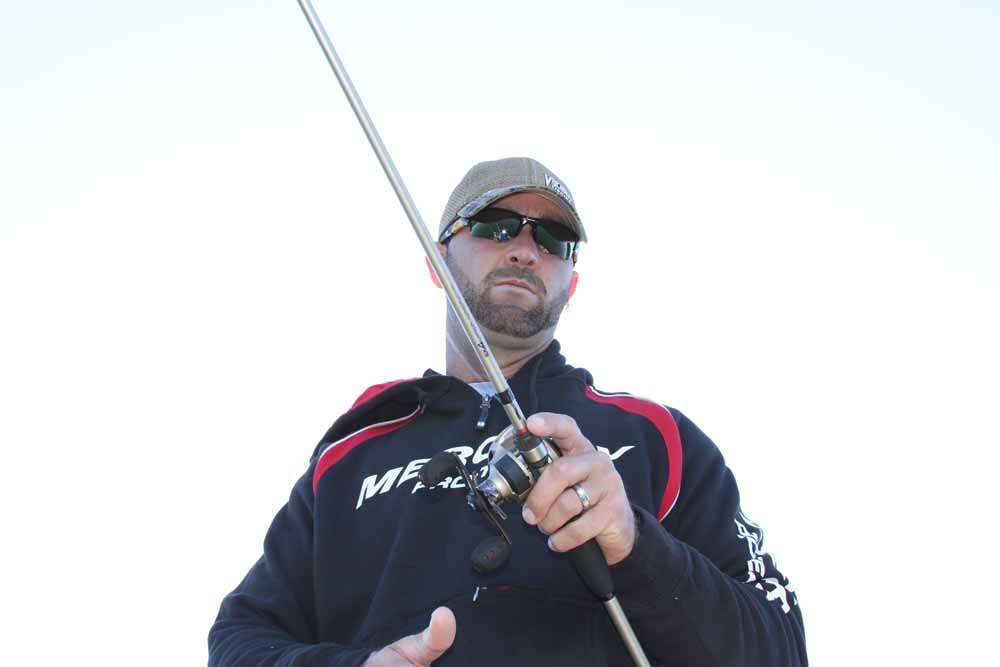
When the bass are stacked up in the backs of the creeks and devouring shad, catching them can be easy.
Crankbait, spinnerbait, buzzbait or jig. Get one of those baits close to shallow cover, and you’re going to get bit.
But what happens in late fall when the fish pull away from the obvious areas?
“That was always a dilemma for me,” says Elite pro Gerald Swindle. “When the water temperature starts to drop, those fish start pulling out of the backs of the creeks and move toward the main lake. They get very tough to find.”
Swindle says he solved that riddle by accident one day while fishing his way out of a creek.
“I broke off a jig,” he recalls. “When I got in my tackle to get another, I saw this small jigging spoon and decided to give it a try. It really was a desperation move.”
And a good one.
Swindle began casting the short, 1/2-ounce War Eagle Spoon along the creek channel ledge. The ledge dropped off into 20 feet of water.
He caught one. Then another. Then another.
“That’s when I realized the bass were feeding on large balls of smaller shad,” Swindle adds. “Those shad spawned earlier that year and were holding deeper in the channels. The bait matched them perfectly.”
Today, it’s a pattern that he fishes when the water temperature drops into the mid to lower 50s and bass aren’t visibly feeding near the surface. It stays effective most of the winter.

Larger, more traditional jigging spoons might work, too, but he believes the smaller version matches the size of the baitfish perfectly. You can even go down to a 1/4 ounce if the fish aren’t taking the 1/2-ounce version.
“It really unlocked the mystery for me and has become a reliable technique I use in early winter,” Swindle insists.
A major benefit of the small spoon, he notes, is it works well as a search bait, enabling him to cover a lot of water quickly until he finds the fish. And because of its smaller size, it sinks slower and is less likely to hang up.
“I fish it like you would a big Texas rigged worm,” he explains. “I make a long cast, hold the line as the bait falls, reel down to maybe 8 o’clock position, then stroke it gently up to the 11 o’clock position.”
Don’t “jerk” the spoon, he cautions. Simply lift the rod tip and let the spoon flutter back, keeping the line tight to maintain contact with the bait at all times. Let it touch the bottom before the next stroke.
“Once you locate the school, you can get over the top of them and work it vertically, too,” he offers. “But really, casting it like a worm works like a charm.”
Swindle says bass will wander up and down the ledge, but often hang around a specific piece of structure or cover that he locates on his electronics. There’s usually one spot that serves as their central location.
“But remember, it’s the bait that they are relating to,” he offers.
You’ll catch a variety of fish species, too, which adds to the fun of fishing on a cold day.
“I call this my cold-front fighter,” he jokes.
Silver is his favorite spoon color, especially on sunny days, when the tactic works best. If it’s cloudy, he’ll opt for gold or white spoons.
“If there’s spotted bass in the lake and it’s overcast or low light, I will take a marker and add a little chartreuse to the white spoon,” Swindle says. “Spots seem to bite that better.”
He fishes the spoon on Quantum EXO baitcast tackle, using a 7-foot medium or medium-heavy rod and 12- or 14-pound Vicious Fluorocarbon line.
“Don’t use too heavy of line or you will overpower the bait,” he explains.





